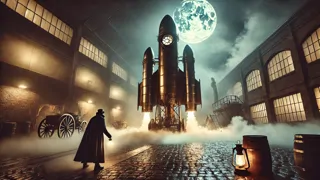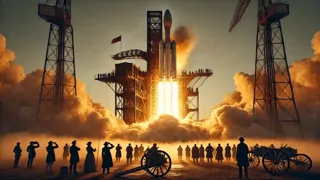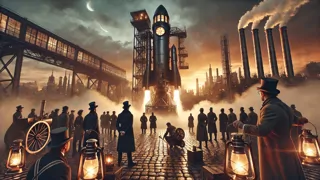Introduction
On the eve of the 1870s, amid the clamor of factory whistles and the hiss of steam engines, a new frontier beckoned above the smog-choked skylines of industrial cities. The world’s Great Powers—United States, Great Britain, France, and Germany—found themselves gripped by an audacious vision: to breach the heavens with a steam-driven rocket unlike anything the age had ever known. At a hidden plateau near Pittsburgh's ironworks, American engineer William Hunt stood before the skeletal frame of what he christened Stephenson's Rocket, a tribute to the pioneering locomotive genius of George Stephenson but propelled skyward by coal-fired boilers and high-pressure steam. Ancient myths of Icarus danced in his mind as he tightened brass fittings that gleamed like firelight. As Hunt and his multinational team wrestled with wrought-iron struts, seething pressure valves, and silk-lined gauges calibrated to inches, diplomats and industrial magnates journeyed from London's fog-bound docks, Paris's gaslit boulevards, and Berlin's baroque palaces to stake their national prestige on this daring enterprise. Beyond the mechanical trials, this was a drama of wills—political intrigue threaded through every rivet and piston. Rival engineers covertly studied blueprints under the glow of lanterns, spies prowled the round houses after dark, and journalists filed breathless dispatches to newspapers across continents. Local townsfolk paused their daily routines—blacksmiths poised mid-strike, laborers clutching calloused hands—drawn by the thunderous echoes of test boilers. Some whispered of hubris, warning that man should not meddle with the celestial realms, while others placed their faith in the ironclad promise of steam. Yet here, beneath a sky tinted by factory haze, the lines between fear and hope blurred, forging Hunt's destiny and that of every soul brave enough to reach for the stars.
Forging the Rocket
In the heart of Allegheny County, where iron forges glowed like captured suns and the air shimmered with ember-laden heat, the skeleton of Stephenson's Rocket took shape beneath a canopy of rationed sunshine and drifting smoke. William Hunt, clutching a leather-bound journal filled with schematics, paced across the sprawling grounds of the Union Foundry, his fingers tapping a restless Morse rhythm against his thigh. Around him, steelworkers in soot-smudged waistcoats labored under the dull roar of steam hammers, forging precision plates of wrought iron that would later become the rocket's load-bearing ribs. Brass artisans, their goggles reflecting amber glints, bent gleaming tubes through molds heated red-hot, each coil meticulously aligned with Hunt's exacting measurements. From distant Lancashire shipments arrived heat-treated bolts stamped with the insignia of Count d'Arlon's Parisian laboratory and Prussian iron contractors, a silent reminder of the international stakes surrounding this audacious creation. Engineers in frock coats gathered at mahogany drafting tables under the flicker of gas lamps, debating valve tolerances and the merits of a tiered boiler design capable of sustaining continuous high-pressure steam. As they sketched alternatives in chalk dust, a chorus of hissing pipes and the rhythmic clang of rivets echoed across the cavernous workshop, a symphony of ambition and metallic resolve. Newsboys clambered onto crates beyond the iron gates, hawking editions that heralded 'Rocket That Will Break Earth's Chains,' while mechanics consulted arithmetic charts pinned above benches cluttered with pressure gauges and trial engine cutaways. Each measured pulse of steam, each deft twist of a spanner, and every hushed negotiation over brass alloy composition spoke to a singular purpose: to sculpt from iron and fire a vessel worthy of breaching the firmament, carrying the pride of nations on a crest of vapor and steel. As Hunt traced a fingertip along the edge of an intricate nozzle design, his mind raced with visions of weightless ascent, momentarily slipping the gravity well that had bound his ancestors to coal-dusted earth. Beneath the sprawl of girder scaffolding, the furnace's glow danced across Countess Emilia's delicate porcelain teacup, brought as a diplomatic gift from Paris, and a humble relic of civility in a forge consumed by industrial urgency.

Beyond the scintillating hearth of raw metallurgy, a second wing of the compound housed the brain trust of mathematicians, chemists, and hydraulics specialists who labored to transform raw calculations into tangible propulsion. In a vaulted chamber lined with mahogany walls and lacquered maps, Hunt collaborated with Dr. Adelaide Voss, a French physicist whose pioneering work with steam condensers promised to double the efficiency of the boiler system. Together they poured over charts of vapor pressure curves, scribbling margin notes in multiple languages as they deliberated the merits of a regenerative coil lined with Austrian borosilicate glass. Nearby, Herr Friedrich Klein of Berlin tapped into his family's dynastic wealth to finance an experimental fuel blend—a secret compound rumored to contain trace quantities of nitrate salts from the Bavarian Alps. The interplay of national techniques sparked spirited debates: British carriage engineers advocating ballast adjustments, American machinists insisting on domed rivet patterns to minimize stress points, and Italian naval architects proffering curved hull plating derived from recent submarine hull trials. Steam pistons underwent tremor tests beneath hydraulic presses, with sensory technicians charting microfractures that could signal catastrophic failure under lift-off strain. Every trial recorded volumes of data, mapped against blueprints pinned beside glowing oil lamps and annotated in Hunt's spidery script. Through it all, the impossible challenge of balancing thrust-to-mass ratios became a matter not just of physics, but of diplomatic prestige, as emissaries from four empire chancelleries demanded regular progress reports. While Lancaster's heavy dray horses rumbled beyond the workshop gates, laden with coal bunkers bound for engineers' nightly fuel trials, the men and women of the Rocket Initiative pursued quiet breakthroughs that would determine which nation would stake its flag on the edge of the unknown. It was here, amid the hush of strategic counsel and the clatter of riveted prototypes, that the fate of Stephenson's Rocket was both written and rewritten, forged by intellect as much as by iron.
Though competition was fierce, unexpected alliances formed in the shadows of patent disputes and clandestine strategy sessions. When French machinists encountered stubborn alignment flaws in the upper fin assemblies, British blacksmiths—once staunch rivals—offered to recalibrate forging molds using precision patterns borrowed from locomotive joinery halls. In turn, American inventors shared their recently perfected water-injection system to regulate steam temperature peaks at critical burnout phases. This tapestry of collaboration unfolded against a backdrop of espionage, as discreet intelligence agents moved ghostlike among corridors, photographing cipher-inked blueprints by candlelight. Rumors of sabotage circulated in telegram dispatches, prompting midnight inspections of coal reserves and chemical stores sealed under imperial seals. Despite these undercurrents of suspicion, a spirit of collective ingenuity prevailed: as Hunt himself observed, the relentless pursuit of knowledge transcended boundaries of language and nationality. In hushed voices he likened the initiative to an ironclad alliance—not of armies, but of ideas—where a single flaw in a valve design could imperil the aspirations of every participating state. Evening debates echoed through marble-pillared salons, where ambassadors toasted to the triumph of science and the promise of cosmic discovery, all while wondering which nation would emerge as the rightful pioneer of a steam-propelled voyage to the firmament. By the time the first components joined in a preliminary assembly at the launch platform, the contours of an unprecedented international order had begun to materialize, drawn from the same blueprint that promised to carry a thousand hopes heavenward.
Rivalries Unleashed
As crisp autumn winds swept across the wind-scarred dunes of the Nova Scotia proving grounds, the assembled rocket stood like a sleeping iron giant beneath a punctured sky. Hunt's team had transported the completed fuselage in reinforced rail carriages, its brass contours shining dully under scattered lanterns that punctured the evening gloom. French chemist Lucille Marceau oversaw the delicate infusion of her patented steam condensate enhancer, while German technician Otto Reinhardt calibrated the pressure regulators with mechanical precision learned from naval artillery work. British Captain Edwin Caldwell, assigned as liaison by the Royal Society, strode among the throng of engineers, his top hat tipped defiantly against the chill. All eyes turned skyward when a distant whistle heralded the arrival of the American fuel train, its loaded tank cars carrying a volatile brute blend derived from Appalachian coal tar and Siberian nitrites. Within minutes, the hissing of steam met the clatter of pistons as test boilers roared to life, the platform trembling beneath the combined forces of four nations' greatest technical minds. Yet beneath the veneer of order, an undercurrent of tension crackled: rumor had spread that a saboteur lurked among the assemblers, waiting to wrench a valve at the critical moment when the pressure chute would seal.

In the half-light, shadows played tricks on weary eyes, and every misplaced wrench or loosened flange felt like the machinations of enemy hands. When a wrench lug was discovered bent out of shape, suspicions flared: was it a careless accident or the signature of an industrial spy? Hunt convened an emergency council beneath a canopy of canvas tarps, his voice measured but urgent as he ordered meticulous inspections of every joint and seal. French and British engineers paired off, cross-checking torque calibrations with rival logbooks, while Reinhardt's Prussian aides performed chemical swabs on the coal bunkers, seeking trace contaminants from foreign suppliers. Telegrams crackled in from Paris and Berlin demanding accountability; the French ambassador waxed hysterical over alleged British infiltration, while Berlin's envoy grumbled that American security protocols were too lax. Through it all, Marceau sketched improvised flow charts on a grease-stained blackboard, proposing a bypass duct that could isolate any malfunctioning chamber mid-launch. When the midnight oil guttered low and the last gauge was tightened, Hunt allowed himself a rare, tired smile. He knew the rocket was as ready as it could be—and that the specter of sabotage, whether proven or not, had only steeled their resolve.
At the heart of their conflict lay more than national pride; it was a contest over the soul of progress. Newspaper headlines in London decried 'Steam Age Overreach,' while Parisian satirists printed cartoons depicting Hunt and his cohorts as Prometheus stealing fire from the gods. In Berlin, postcards circulated portraying Stephenson's Rocket as a weapon of imperial aggression, a tool to subjugate ones who dwelt beneath its exhaust plume. Yet in quiet corners of the launch encampment, engineers spoke not of conquest but of curiosity: what lay above the dense cloud deck, where stars flickered like distant possibilities? It was this shared wonder that galvanized them through fraught logistics and diplomatic rear-guard actions. When the final countdown was set, each valve marked, each crew member attuned to the slightest hiss or tremor, it was no longer a mere competition of the Great Powers but a communion of minds dedicated to unlocking a new horizon. They stood at the precipice of a moment that would reverberate through scientific journals and state papers alike—the culmination of rivalries, sacrifices, and the unshakeable conviction that steam and steel could propel humanity beyond the firmament's once-impenetrable veil.
Lift Off at Dawn
As predawn mist clung to the englobe of the vast launch platform, the assembled delegations of four empires lay shrouded in soft luminescence cast by lantern fleets tied to ornate iron bollards. Hunt, clad in a stained frock coat bearing railroad insignias, ascended the scaffold steps with deliberate calm, his breath rising in silvery plumes as he carried the ceremonial wrench that would release the primary steam valve. On the opposite side, Lady Arabella Fairfax, representing the British Crown, adjusted her lace opera gloves while reporters sketched her stoic profile for daily broadsheets. Beneath a sky striped in charcoal and rose, the rocket's silhouette loomed, its brass fittings catching the first whisper of dawn, and an expectant hush settled over the throng of mechanics, diplomats, and foreign dignitaries who had traveled continents to witness this moment. The countdown was encoded in the measured beating of a bass drum, each strike echoing across the wooden planks, synchronizing the hearts of countless spectators. As the final drumbeat faded, Hunt fitted the wrench at the valve's wheel flanges and exhaled a wordless prayer born of hope and seasoned steel.

When the wheel turned, a tremor rippled through the launch cradle; steam hissed and billowed like the sighs of a long-dormant titan awakening from iron slumber. The boiler roared into life, its scarlet glow visible through polished pressure gauges, and pipelines groaned under the sudden influx of coal-fired fury. The rocket's portholes glowed like molten jewels, and for a heartbeat, the world held its breath until a thunderous roar shattered the calm. A ribbon of fire and vapor spiraled skyward, the platform shuddering as thousands cheered, hats tossed, and flags unfurled in a riot of color. Even the skeptics among the press found their cynicism eclipsed by the primal grandeur of raw steam thrusting an iron colossus toward limitless blue. With each second passing the altitude scale etched on the staging tower, the rocket shed weight like a giant serpent molting bark, its momentum accelerating in an ecstasy of mechanical determination.
As Stephenson's Rocket climbed beyond the reach of cranes and gas lamps, its travelers felt the gentle tug of weightlessness, a sensation that no courtly ball or naval voyage had ever imparted. The engines hummed in perfect unison until the secondary stage jettisoned its spent boilers, cascading into the morning haze below. Gasps rippled through observation decks and field telegraphs crackled with ecstatic reports: for the first time, human ambition had transcended the earthly tether. In the days that followed, newspapers heralded the ascent as proof that steam power and collaborative spirit held the keys to the firmament. Hunt and his international team were immortalized in portraits that spanned continents, while scientific academies convened to plan further expeditions into the upper atmosphere. Though the journey was suborbital and brief, it carried ramifications that would echo through every lecture hall and laboratory for decades. The steam age had, at last, extended its dominion to the edge of space, forging a legacy of courage and perseverance that would inspire generations to follow.
Conclusion
Amid the flutter of banners and the echo of triumphant applause, the engineers of Stephenson's Rocket stood as living testaments to the union of bold imagination and industrial mastery. In the cool aftermath, Hunt traced the rocket's ascent line on a brass barometer, imagining future voyages that might pierce the moon's pale face or map the heatless void beyond. Yet beyond technical triumphs, the rocket's flight awakened a profound truth: that collaboration among rival nations could yield feats surpassing the wildest dreams of solitary visionaries. Rivalries had stoked their competitive fires, but mutual respect and the relentless pursuit of discovery had forged an alliance stronger than iron. Letters poured in from towns across continents, from mechanics who dreamed of hanging rocket pods at forging forges to scholars who revised textbooks to include the possibility of cosmic exploration. The industrial age, long defined by earthbound achievement, had at last embraced the sky itself as its canvas. As coal ash settled over fields once used for horse-drawn carriages, humanity looked upward with fresh wonder, ready to scale ever greater heights on the steam and courage borne of a Victorian dream.
















